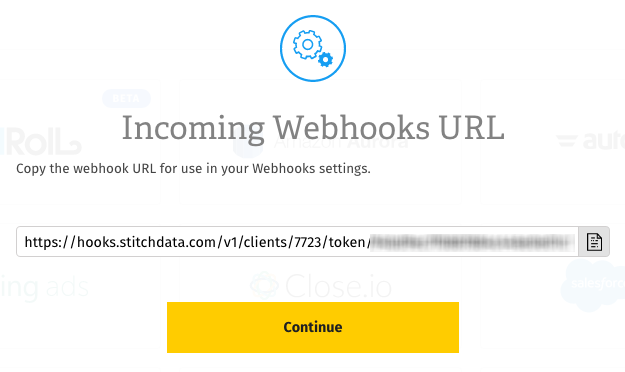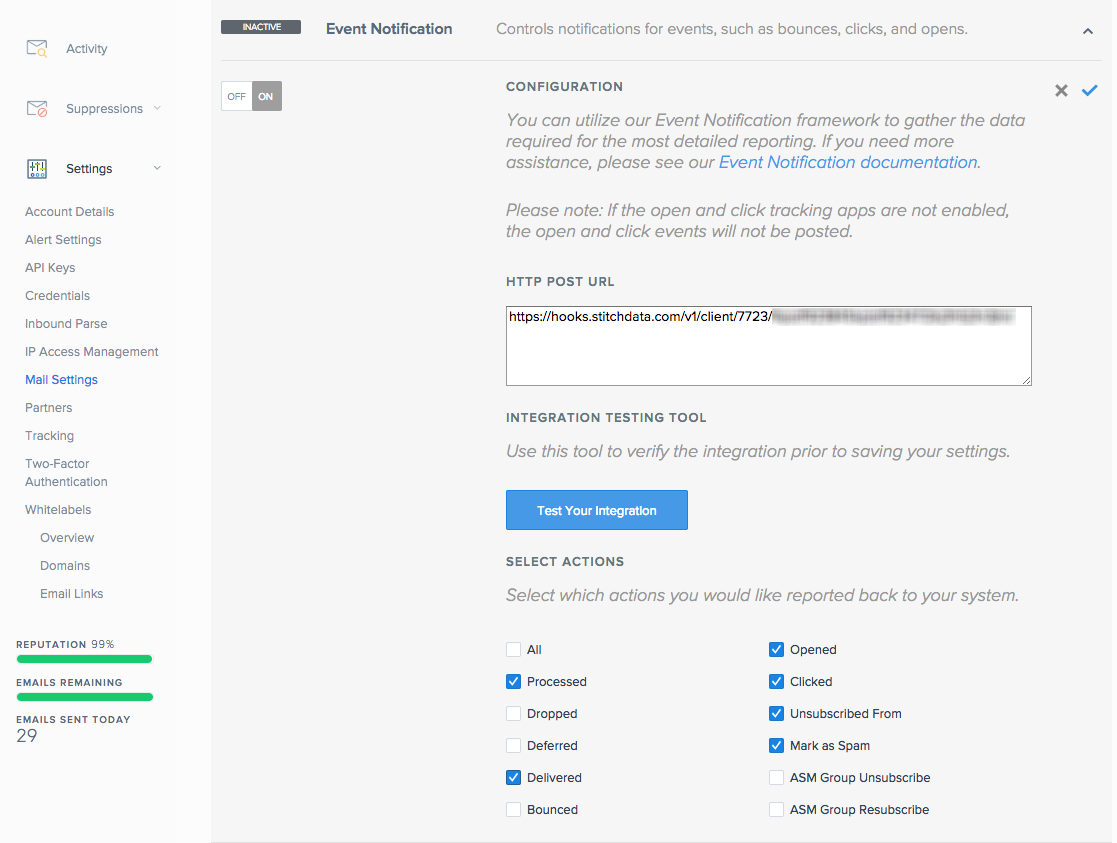Our SendGrid integration is currently in Open Beta. As such, the info in this article may change.
| Release Status | Open Beta | Availability | Free |
| Status Page | SendGrid Status Page | Default Historical Sync | None |
| Whitelist Tables/Columns | Unsupported/Unsupported | Default Replication Frequency | Continuous |
| Destination Incompatibilities | None | ||
Connecting SendGrid
Connecting SendGrid to Stitch is a three-step process:
Generatea SendGrid Webhook URL in Stitch
- On the Stitch Dashboard page, click the Add an Integration button.
-
Click the SendGrid icon.
-
Enter a name for the integration. This is the name that will display on the for the integration; it’ll also be used to create the schema in your data warehouse.
For example, the name “Stitch SendGrid” would create a schema called
stitch_sendgridin the data warehouse. This schema is where all the tables for this integration will be stored. - Click Save Integration.
Generating a SendGrid Webhook URL
Once Stitch has successfully saved and created the SendGrid integration, you’ll be redirected to a page that displays your SendGrid webhook URL and token (which is blurred in the image below):

Click the Copy button to copy it.
Note that this particular URL won’t display in Stitch again once you click Continue. Think of this URL like you would your login or API credentials - keep it secret, keep it safe. You can, however, generate another URL should you need it.
Once you’ve copied your webhook URL, click Continue to wrap things up in Stitch.
Setting Up Webhooks in SendGrid
The last step is to setup webhooks in your SendGrid account.
- Sign into your SendGrid account.
- In the pane on the left side of the screen, click Settings.
- In the Settings menu, click Mail Settings.
- Click Event Notification. This will expand the notification settings.
- Click On to enable event notifications.
- In the HTTP Post URL field, paste the Stitch-generated webhook URL.
-
In the Actions section, select the action types you want to send to Stitch:

- When finished, click the checkmark on the right side of the notification settings.
Replication
After you’ve successfully connected your SendGrid integration, Stitch will continuously replicate your webhook data into your data warehouse.
Webhooks & Historical Data
Because SendGrid data is sent to Stitch in real-time, this means that only new records are replicated to your data warehouse. Most webhook-based integrations don’t retain historical data due to this as-it-happens approach.
In the event that our webhook service experiences downtime, you may notice some lag between an event occurring and the data appearing in your data warehouse.
Method
This version of Stitch’s SendGrid integration uses Append-Only Replication. Append-Only Replication is a type of Incremental Replication where newly replicated data is appended to the end of a table. Existing rows are not updated - any updates will be added to the table as new rows. Data stored this way can provide insights and historical details about how those rows have changed over time.
Querying for the Latest Data
If you simply want the latest version of the object - or objects, if you elected to track more than one during the setup - in the integration’s table (data), you’ll have to adjust your querying strategy to account for the append-only method of replication. This is a little different than querying records that are updated using updated_at Incremental Replication.
To do this, you can use the _sdc_sequence column and the table’s Primary Key. The _sdc_sequence is a Unix epoch (down to the millisecond) attached to the record during replication and can help determine the order of all the versions of a row.
If you wanted to create a snapshot of the latest version of this table, you could run a query like this:
SELECT * FROM [stitch-redshift:stitch-sendgrid.data] o
INNER JOIN (
SELECT
MAX(_sdc_sequence) AS seq,
[primary-key]
FROM [stitch-redshift:stitch-sendgrid.data]
GROUP BY [primary-key]) oo
ON o.[primary-key] = oo.[primary-key]
AND o._sdc_sequence = oo.seqThis approach uses a subquery to get a single list of every row’s Primary Key and maximum sequence number. It then joins the original table to both the Primary Key and maximum sequence, which makes all other column values available for querying.
Schema
The schema of the tables created by your SendGrid integration will contain two “types” of columns: columns used by Stitch (prepended with _sdc) and the columns send by the provider’s webhook API.
Aside from the Stitch columns, the table schemas will depend entirely on SendGrid’s webhook API. With the exception of the _sdc fields, Stitch does not augment Incoming Webhooks data nor does it have any control over the fields sent by the webhook provider.
events
Replication Method: Append-Only (Incremental)
Primary Key: event:email:timestamp
Contains Nested Structures?:
No
events table contains details about events.The attributes listed below may not be applicable to every single event type - because of this, you may see some rows that have NULL values.
events Attributes
While we try to include everything SendGrid has here, this may not be a full list of attributes. Refer to SendGrid's documentation for a full list and description of each attribute.
event
email
timestamp
asm_group_id
attempt
category
cert_err
ip
reason
response
sg_event_id
sg_message_id
smtp_id
status
tls
type
url
url_offset_index
url_offset_type
useragent
events__category
Replication Method: Append-Only (Incremental)
Primary Key: _sdc_source_key_event: _sdc_source_key_email: _sdc_source_key_timestamp: _sdc_level_0_id
Contains Nested Structures?:
No
events__category table contains info about an event category. This is a subtable of events.events__category Attributes
While we try to include everything SendGrid has here, this may not be a full list of attributes. Refer to SendGrid's documentation for a full list and description of each attribute.
_sdc_source_key_event
_sdc_source_key_email
_sdc_source_key_timestamp
_sdc_level_0_id
value
Webhook URLs & Security
Stitch allows you to generate up to 2 SendGrid webhook URLs at a time. These URLs contain security access tokens and as such, have access to your SendGrid account.
If you ever need to change your webhook URL, you can do so in the Integration Settings page after the integration has been created:
- Click into the integration from the Stitch Dashboard page.
- Click the Settings button.
- In the Webhook URLs section, click the Generate Webhook URL button.
- A new webhook URL will display. Press the clipboard icon to copy it.
- Follow the steps in the Setting Up Webhooks in SendGrid section to update the webhook URL in SendGrid.
- After you’ve updated the webhook URL in SendGrid, click the Revoke button next to the oldest webhook URL in Stitch. This will invalidate the token and revoke access.
| Related | Troubleshooting |
Questions? Feedback?
Did this article help? If you have questions or feedback, please reach out to us.